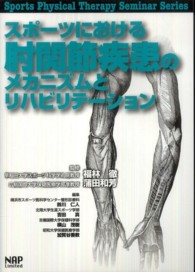- ホーム
- > 洋書
- > 英文書
- > Business / Economics
Full Description
A company exists to make profit, and everything it does is a step towards that goal. Many firms are trying to get closer to their customers, but few realise how crucial this is to corporate value. Indeed, the long-term value of a company is perhaps best described as the sum of future profits from customers, discounted to a present value. Tackling two hot topics in business - CRM and corporate value - and based on a study undertaken by the Customer Management Leadership Group, John Murphy's new book links customer management directly to company profitability for the first time. By implementing its Customer Management Integration Framework, a company can see cash flows for each customer relationship, and use that information to effectively manage key customers for higher and more resilient levels of profitability.
Contents
Acknowledgments xiii
Introduction xv
1. The Customer Profit Conundrum 1
Common misperceptions about customer profitability 2
An overview of customer profitability analysis 6
How to measure profit 6
The nature of customer costs 8
Customer profitability analysis (CPA) and activity-based costing (ABC) 11
A step-by-step approach to measuring customer profitability 16
Getting started with customer profitability analysis 24
Common barriers to customer profitability analysis 27
Running a CPA project 28
The results of CPA 30
Why do companies have unprofitable customers? 32
Improving customer profitability 34
The customer response 37
Management barriers to making changes as a result of CPA 37
Conclusion 38
2. Segmentation 43
Segmentation incorporating profitability 47
Step 1: Completion of customer profitability analysis 47
Step 2: Macro segmentation 48
Step 3: Verification/Reality check 50
Step 4: Micro segmentation 57
Step 5: Investigate if strategies and operations are aligned 59
Step 6: Align operations and implement tactics 65
Conclusion 68
3. Customer Focus 73
Segmenting business markets 75
Segmenting international markets 76
Each customer wants to be treated as an individual 77
Choosing customers 77
Managing the total customer experience 79
Leading the customer experience 80
Managing the impact of delays 81
Employees connect to the customer 83
Customer retention 84
What if customers charged the organisation for their time? 84
Data collection 87
Action plan 90
Listening to customers 92
Complaint management: customer satisfaction 93
Measures influence behaviour toward (or away from) the DCP 96
The ladder of loyalty 97
Recognise and reward loyal customers 97
Gauging customer loyalty 98
Micro-marketing is the ultimate in customer service provision 99
Monitoring performance 100
Why it is vital to build trust 103
Summary 103
4. Processes and Systems 109
Process reviews/Process improvement 112
Customer requirements 115
Identification of key processes 115
Process review 118
Business process re-engineering 122
Quality in the service industries 123
Management's understanding of customers' expectations 128
Complaints 129
Compliments 134
Summary 137
5. Employee Involvement 141
Retention of customers 144
Understanding key concepts 146
Controlling the continuum 147
Recruitment 150
Employee audits 154
Tools for the job 156
The team approach 161
Involve employees in setting performance and service standards 165
Listen to employees 167
Employee motivation 169
Performance indicators 171
Reward and recognition - linked to customer retention 175
What makes a great employer? 179
Employee retention 181
The value of performing exit interviews 182
Summary 184
6. Training and Development 187
Employees are assets 189
There is always a payback 190
Team establishment 192
Identification of training needs 195
Competence-based training 196
Service quality training 199
Teamwork training 201
Coaching 203
Just-in-time training 206
Formal recognition 207
How is the person at the top affected? 208
Managers as trainers 209
Training customers 209
Summary 210
7. Measurement 213
Benchmarking 216
Always measure customer reaction 216
Measurement tool creation 218
All measurements must be followed by actions for improvements 219
Priorities for success 221
How is total measurement relevant to business success? 222
Tracking net promoters 224
Measurement of people 225
Leadership 227
What to measure? 228
Measurement of performance 231
What are the thresholds within which customers decide if an organisation is getting things done right? 235
Managers are judge and jury 237
Who needs to know what? 239
Measurement and response to change 240
Production processes 241
Summary 248
8. Continuous Improvement 251
Advantages of continuous improvement 253
Teamwork takes the strain 253
Problems become opportunities 254
Improvement means shared information and ideas 256
Rewards come from hard work 256
How does one start a service quality initiative and then keep it going forward? 257
Keep outside suppliers of goods and services up to scratch 260
Shopping in the global marketplace 261
Ethical distortion of customer segments 262
Benchmarks 264
Field leaders and their recipe for success 269
How does one measure continuous improvement? 270
Nothing succeeds like success 274
Cost-effective captivity 275
Summary 276
9. Communications 279
Communication can be a response, or it can call for a response 283
Management has an ongoing role 288
Leadership is the key 290
Poor communication is both damaging and unfair to employees 290
What are communications? 291
Body language also sends messages 292
Is every communication necessary? 293
Make it easy for two-way communications 294
To the rest of the world, we are foreigners 295
Effective internal communication 296
Monitor the effectiveness of communication 297
Team briefings 297
Keep it simple 301
Keep the door open to doubters 302
Summary 303
10. Culture 307
What exactly do we mean by corporate culture? 307
Beginning to develop a culture 309
Think Christmas pudding 312
Hussey's easier approach to fundamental change 319
Rule books 319
Growing and sustaining a customer-focused culture 321
Trust 325
The decline in customer satisfaction 329
Summary 337
Cycle of success 340
Case Study 1: Alfred McAlpine Business Services Limited 341
Case Study 2: Centrica 351
Case Study 3: Eversheds 355
Case Study 4: National Blood Service 359
Case Study 5: Shell 367
Bibliography 373
Index 381








